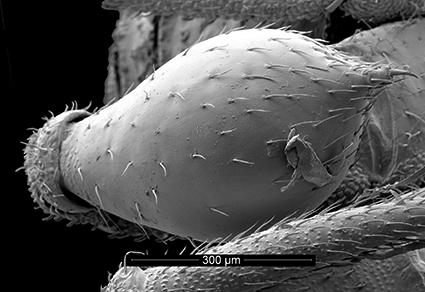Abstract
A new species, Amplaria oedipus, is described from Oregon, USA. Males of the new species have greatly inflated pyriform tarsi on the 5th and 6th legpairs, which is a secondary sexual modification previously not known from any other millipede.
References
Bollman, C.H. (1888) Notes upon a collection of Myriapoda from East Tennessee, with a description of a new genus and six new species. Annals of the New York Academy of Sciences, 4 (106), 1–12.
Bollman, C.H. (1893) The Myriapoda of the United States. United States National Museum Bulletin, 43, 1–210.
Bond, J.E., Godwin, R.L., Colby, J.D., Newton, L.G., Zahnle, X.J., Agnarsson, I., Hamilton, C.A. & Kuntner, M. (2021) Improving taxonomic practices and enhancing its extensibility–an example from Araneology. Diversity, 14, 1–15. http://doi.org/10.3390/d14010005
Chamberlin, R.V. (1941) New Western millipeds. Bulletin of the University of Utah, Biological Series, 31 (2), 6, 3–23.
Hennig, E. (1915) Kentrosaurus aethiopicus, der Stegosauridae das Tendaguru. Sitzungberichte der Gesellschaft Naturforschender Freunde zu Berlin, 1915, 219–247.
Kemperman, T. & Gittenberger, E. (1988) On morphology, function and taxonomic importance of the shell ribs in Clausiliidae (Mollusca: Gastropoda: Pulmonata) with special reference to those in Albinaria. Basteria, 52, 77–100. [https://natuurtijdschriften.nl/pub/596881]
Marsh, O.C. (1877) A new order of extinct Reptilia (Stegosauria) from the Jurassic of the Rocky Mountains. American Journal of Science, 3, 513–514.
Shear, W.A. (1973) Millipeds from Mexican and Guatamalan caves. Accademia Nazionale dei Lincei, Problemi attuali di scienza e di cultura, 171, 239–305.
Shear, W.A. (2011) Cave millipedesof the United States. X. New species and records of the genus Pseudotremia Cope. 2. Species from Virginia, USA (Diplopoda, Chordeumatida, Cleidogonidae). Zootaxa, 3109, 1–38.
Shear, W.A. (2020) The millipede family Striariidae Bollman, 1893. I. Introduction to the family, synonymy of Vaferaria Causey with Amplaria Chamberlin, the new subfamily Trisariinae, the new genus Trisaria, and three new species (Diplopoda, Chordeumatida, Striarioidea). Zootaxa, 4758 (2), 275–295. https://doi.org/10.11646/zootaxa.3109.1.1
Shear, W.A. (2021a) The millipede family Striariidae Bollman, 1893. II. New records and species of the genus Amplaria Chamberlin, 1941 (Diplopoda, Chordeumatida, Striarioidea). Zootaxa, 4908 (2), 205–224. https://doi.org/10.11646/zootaxa.4908.2.3
Shear, W.A. (2021b) The millipede family Striariidae Bollman, 1893. III. Four new species of Striaria Bollman, 1888 (Diplopoda, Chordeumatida, Striarioidea). Zootaxa, 4920 (3), 395–406. https://doi.org/10.11646/zootaxa.4920.3.5
Shear, W.A. & Krejca, J.K. (2007) Revalidation of the genus Amplaria Chamberlin 1941 (Diplopoda, Chordeumatida, Striariidae) and description of two new species from caves in Sequoia and Kings Canyon National Parks, California. Zootaxa, 1532 (1), 23–39. https://doi.org/10.11646/zootaxa.1532.1.2
Shear, W.A., Nosler, P. & Marek, P.E. (2017) The identity of Amplaria nazinta (Chamberlin, 1910): a century-old millipede mystery resolved (Diplopoda, Chordeumatida, Striariidae). Zootaxa, 4311(2), 233–240. https://doi.org/10.11646/zootaxa.4311.2.4


